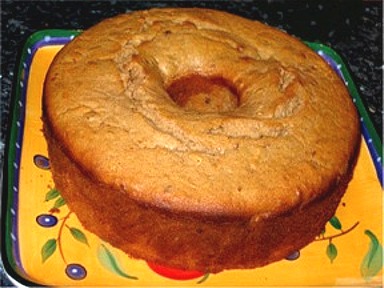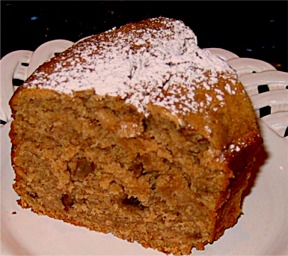Variations: Carrot-Orange Quick-Cake; Festive Zucchini Lemon Quick-Cake

Cake and photo by Sarah Phillips © Sarah Phillips
This makes an exceptionally moist and wonderful all-purpose party cake for casual dining and as an every day snack cake. Besides it smells so delicious as it bakes; the classic combination of baking apples, cinnamon and nutmeg scents waft throughout the house. The Apple Walnut Spice Quick-Cake Recipe bakes best in a tube or Angel Food Cake pan with a removable bottom, not an intricately designed decorative Bundt pan because this cake is very moist and won’t unmold easily in one piece.
I call this Apple Walnut Spice Quick-Cake Recipe a “quick-cake” rather than a “cake” because I feel these types of recipes are unclassified cake souls, lost somewhere between a buttercake and a quick-bread. Both use similar ingredients, but a quick-cake is mixed using a creaming method — the same used in butter cakes — that is beating stick butter with sugar, adding in the eggs next, and then the flour and liquid ingredients are alternately added in, giving it a similar tender and high-risen appearance. The result is a cakelike texture. Most quick-breads are mixed with the liquid and sugar ingredients being added at once to the flour and dry ingredients and then mixed by hand.
CAKE RECIPE HELP

meg: “This is Sarah's apple quick cake. I baked it in a long, narrow loaf pan rather than a tube pan. This was soooooo good!”
INGREDIENTS
3 cups unbleached all-purpose flour, spoon into dry measuring cup and level to top
2 1/2 teaspoons baking powder
1/2 teaspoon baking soda
1 1/2 teaspoons ground cinnamon
1/2 teaspoon ground nutmeg, if using freshly grated, use 1/4 teaspoon
1 teaspoon salt
1 1/3 cups buttermilk, well shaken
2 teaspoons vanilla extract
2 sticks (1 cup) unsalted butter
3/4 cups sugar
3/4 cups dark brown sugar, packed
3 large eggs
1 large egg yolk
1 cup peeled, cored and shredded Granny Smith apple, about 1 medium; Golden Delicious can also be used.
1/2 cup finely chopped and toasted (optional) walnuts, cooled; chop, toast and then measure
INSTRUCTIONS
1. Position the oven rack in the center of the oven and preheat the oven: In my oven, with six rungs, this is considered the third rack up. When you have an even number of racks, and have to choose as to whether the third or fourth rack up is the middle, as I do in my oven, when in doubt, go to the lower rack of the two.
Preheat the oven to 350 degrees F. NOTE: Reduce the oven heat by 25 degrees F if using a dark, nonstick or glass, ovenproof pan.
2. Prepare a 10-inch tube pan WITH REMOVABLE BOTTOM; for this cake spray generously with vegetable oil spray or grease with shortening or butter and set aside.
SARAH SAYS: Use a light colored aluminum pan called an “Angel Food” Cake or Tube Pan. Many stores still call the pan a “tube” pan because of the tube in the center
3. In a medium bowl, with a large spoon, blend the dry ingredients: combine the flour, baking powder, baking soda, cinnamon, nutmeg and salt.
Add the vanilla to the measured buttermilk and stir together.
4. In the bowl of a stand mixer, beat the butter on low speed with a paddle attachment until softened. Add the granulated sugar in a steady stream at the side of the bowl Stop the mixer and scrape the side of the bowl often. Add the brown sugar in small clumps and beat until combined. Increase the mixer speed to medium and beat for 2 to 3 minutes. Before moving to the next step, stop the mixer and scrape the side and bottom of the bowl with a rubber spatula.
5. With the mixer on low, add the eggs, one at a time, and the egg yolk, and beat for 20 seconds after each. Stop the mixer and scrape the bowl often. After the eggs and yolk are added, increase the mixer speed to medium and beat the mixture for one minute until it is homogenous and fluffy. The mixture will increase in volume which comes from your further beating air into the mixture.
SARAH SAYS: After the butter and sugar are creamed and then the eggs are added one at a time, creating an emulsion. It is defined as the mixture of two liquids, such as oil and water, that don't naturally combine smoothly, formed by the suspension of one liquid in another. Since butter and eggs both contain fat and water, it is necessary to beat them together until well incorporated. The mixture should look homogenous, not curdled or separated. If it is separated, it is caused by adding cold eggs to a warmer butter and sugar mixture. Don't continue to mix; the mixture will come back together again when you add the flour.
6. With the mixer still on low speed, add the flour mixture in 3 equal portions, alternating with the buttermilk mixture, starting and ending with the flour mixture. Mix until just incorporated.
The batter should be thick, homogenous and slightly fluffy.
Stop the mixer and remove the bowl when there are a still a few wisps of flour showing. Don't worry about mixing in all of the flour at this point otherwise you will overmix the batter. If you do, the cake will be dry and flavorless.
SARAH SAYS: Most butter cake recipes have you add in the dry ingredients in three or four equal parts, alternating with the liquid ones, in two or three equal parts, beginning and ending with the dry. The steps are done this way to prevent having a tough cake. They also prevent the fat in the batter separating from the liquids, breaking the emulsion and releasing or breaking the air bubbles, so essential to good taste and texture.
7. Lightly distribute the apples and walnuts on top. With a large rubber spatula, fold in the ingredients until just combined. Make sure you scrape the sides and bottom of the bowl. During folding, you will incorporate the last remaining wisps of flour.
8. Scrape batter into the pan and smooth the top.
SARAH SAYS: I found the easiest way to smooth the batter in a pan is to first spray the underside of a large soup spoon with vegetable oil spray. Then use the underside to lightly and quickly smooth the batter. The oil on the spoon will help prevent the batter from sticking to it. Use a light touch – don't press down on the batter when you do otherwise you will pop the air bubbles in the batter. Smooth the batter quickly – the more you play with the batter, the more you create gluten and toughen the cake's top.
9. Bake the cake for 50 to 60 minutes or until the cake is a golden brown in color. The cake will rise a couple of inches. SARAH SAYS: Cakes that contain lots of fruit tend to be dense and do not rise as high as those that don't.
NOTE: The recipe will bake in three 9 x 2-inch cake pans, taking about 30 to 40 minutes.
To check when the cake is done, insert a long skewer halfway between the side of the pan and the central tube and remove it. The skewer should emerge with a few moist crumbs attached rather than batter. The cake should also feel firm and give slightly when pressed lightly with a fingertip. Remove the pan from the oven to a wire cake rack and LET THE CAKE COOL IN THE PAN.
SARAH SAYS: Expect the top of the cake to crack and be uneven, typical in these types of cakes because of the low amount of sugar and fat in relation to flour.
10. Unmold the cake after it has cooled thoroughly in its pan. To do: slowly trace around the perimeter of the inner tube with a knife, scraping against the pan rather than the cake. When loosened, push up the bottom to remove the cake from the outer ring. The central tube will be attached.
With a thin-bladed, flexible knife, carefully trace around the bottom of the pan and the cake, scraping against the pan rather than the cake. It will simply fall onto the wire cake rack. Gently lift the cake layer from the central tube and pan bottom while supporting the bottom of the layer with your hands. Remove the layer to a flat serving platter. Dust lightly with confectioner's sugar while sifting through a fine mesh strainer.
SERVE
Use a sharp knife to cut the cake. It will crumble if you use a dull or serrated knife. Optionally, serve with whipped cream or fresh fruit.
STORAGE
Store the thoroughly cooled cake covered at room temperature for about 3 – 5 days or freeze.
To freeze, do not dust with powdered sugar beforehand. Wrap in plastic wrap and then foil. For best results, then place in an airtight plastic bag with the air taken out and freeze. It will keep for about 2 months. Thaw the cake at room temperature in its original wrapping.

Cake and photo by Sarah Phillips © Sarah Phillips
VARIATIONS
Carrot-Orange Quick-Cake
Festive Zucchini Lemon Quick-Cake


